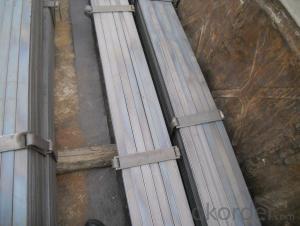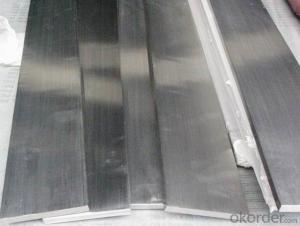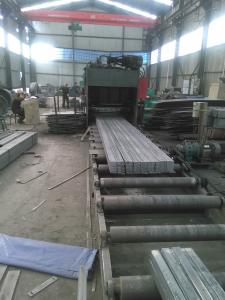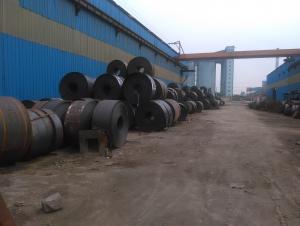flat bar
- Loading Port:
- China Main Port
- Payment Terms:
- TT OR LC
- Min Order Qty:
- -
- Supply Capability:
- -
OKorder Service Pledge
OKorder Financial Service
You Might Also Like
Product Description:
Specification of Mild Steel Flat Bar
Commodity: Mild Steel Flat Bar
Standard: GB;JIS
Material: Q195-235;SS400
Brand name: FLATSPACE
Origin place: China
Thickness: 3mm-30mm
Width:20mm-200mm
Length: Max 12m
Certification: SGS/BV
Chemical composition of Q235
Alloy No | Grade | Element(%) | ||||
C | Mn | S | P | Si | ||
Q235 | B | 0.12—0.20 | 0.3—0.7 | ≤0.045 | ≤0.045 | ≤0.3 |
Physical properties of Q235
Alloy No | Grade | Yielding strength point(Mpa) | Tensile strength (Mpa) | Elongation after fracture(%) | ||||||
Thickness (mm) | Thickness (mm) | |||||||||
≤16 | >16--40 | >40--60 | >60--100 | ≤16 | >16--40 | >40--60 | >60--100 | |||
≥ | ≥ | |||||||||
Q235 | B | 235 | 225 | 215 | 205 | 375--500 | 26 | 25 | 24 | 23 |
Usage/Applications of Mild Steel Flat Bar
Widely used for construction, Machinery manufacturing, Iron tower steel structure, Shipbuilding; Steel grating, Staircase, Bridge, Viaduct, Railway spare parts, Boilers making etc.
Packaging & Delivery of Mild Steel Flat Bar
Packaging Details: The Mild Steel Flat Bars are packed in bundles and loaded in 20 feet/40 feet container, or shipped by bulk cargo ,also we can do as customer's requirements.
Delivery Details:30~45 days upon the receipt of buyer payment by T.T. or L/C.
Production Flow of Mild Steel Flat Bar
The Mild steel flat bar is made through three processes:
1.Feeding the material: Feeding the row material (the steel plate) to Slitting Line.
2.Slitting:The steel plate would be slitted into expected width by lengthways cutter.
3. Leveled and cutting: The plat bar would be ground into level by the grinder and then cut into required length
- Q:What are the common methods of protecting steel flat bars from corrosion?
- The common methods of protecting steel flat bars from corrosion include applying protective coatings such as paint or powder coating, using galvanization to create a protective zinc layer, employing corrosion inhibitors, and implementing proper maintenance practices such as regular cleaning and inspections.
- Q:Can steel flat bars be used for architectural applications?
- Yes, steel flat bars can be used for architectural applications. Steel flat bars are versatile and durable, making them suitable for various architectural projects. They can be used for structural support, such as in beams and columns, as well as for decorative purposes, like in handrails or trim details. Steel flat bars can be easily fabricated and shaped to meet specific design requirements, allowing architects to create unique and visually appealing structures. Additionally, steel flat bars are available in a wide range of sizes and finishes, offering architects flexibility in selecting the most suitable material for their architectural projects.
- Q:Are steel flat bars available with pre-drilled holes?
- Yes, steel flat bars are available with pre-drilled holes. These pre-drilled holes are commonly used to facilitate easy installation and provide a secure attachment point for various applications. Pre-drilled holes can be found in different sizes and patterns, depending on the specific requirements of the project. The availability of pre-drilled holes on steel flat bars offers convenience and time-saving benefits for users, as it eliminates the need for additional drilling or machining. Whether it is for construction, furniture assembly, or industrial applications, steel flat bars with pre-drilled holes are readily available and widely used in various industries.
- Q:Can steel flat bars be used for making brackets or brackets?
- Certainly, brackets or brackets can indeed be made using steel flat bars. With its strength and durability, steel proves itself suitable for a wide range of applications, including the production of brackets. By easily shaping, cutting, and welding steel flat bars, brackets of diverse sizes and shapes can be effortlessly crafted. These brackets offer stability and support, making them perfect for holding objects or providing structural reinforcement. Furthermore, the corrosion resistance of steel ensures its reliability for brackets that may come into contact with moisture or endure harsh environmental conditions.
- Q:What are the common methods of surface cleaning for steel flat bars?
- There are several common methods for surface cleaning steel flat bars: 1. Mechanical Cleaning: This method involves the use of abrasive materials such as wire brushes, sandpaper, or abrasive pads to physically scrub and remove dirt, rust, or other contaminants from the surface of the steel flat bars. This method is effective for light to moderate cleaning and can be done manually or with the help of power tools. 2. Chemical Cleaning: Chemical cleaning involves the use of various cleaning agents or solvents to dissolve and remove dirt, grease, oil, or other stubborn contaminants from the surface of the steel flat bars. These cleaning agents may include alkaline or acidic solutions, degreasers, or specialized steel cleaners. It is important to follow the manufacturer's instructions and safety guidelines when using chemical cleaning agents. 3. Pickling: Pickling is a method often used to remove heavy rust or scale from the surface of steel flat bars. It involves immersing the bars in an acidic solution, typically a mixture of hydrochloric acid and water, which dissolves the rust or scale. After pickling, the bars are rinsed thoroughly to remove any remaining acid and then dried. 4. Sandblasting: Sandblasting uses compressed air to propel fine abrasive particles, such as sand or steel grit, at high speeds onto the surface of the steel flat bars. This method is highly effective for removing heavy rust, scale, or old paint coatings. It creates a roughened surface that promotes better adhesion for subsequent coatings or finishes. 5. Electrochemical Cleaning: Electrochemical cleaning, also known as electrolysis or electrocleaning, involves using an electric current to remove rust or other contaminants from the surface of the steel flat bars. The bars are immersed in an electrolyte solution, and the electric current causes the rust to dissolve, leaving a clean surface. This method is often used for delicate or intricate surfaces where mechanical methods may cause damage. It is important to select the appropriate cleaning method based on the level of contamination, type of surface, and desired end result. It is also crucial to follow proper safety procedures and wear personal protective equipment when performing surface cleaning on steel flat bars.
- Q:How do you prevent corrosion on steel flat bars in humid environments?
- There are several effective measures that can be taken to prevent corrosion on steel flat bars in humid environments. One option is to apply a protective coating on the steel flat bars. Coatings such as zinc, epoxy, or polyurethane can be used to create a barrier between the steel surface and moisture. Another method is galvanization, which involves applying a layer of zinc to the surface. This sacrificial anode corrodes instead of the steel, preventing rust formation. Proper storage is also important. Storing the steel flat bars in a dry and well-ventilated area, away from water sources, can significantly reduce the chances of corrosion. Regular cleaning and maintenance are crucial. Removing any dirt, debris, or moisture accumulation promptly is essential. Damaged coatings should be repaired or replaced to maintain protection. In particularly humid environments, using dehumidifiers or other humidity control measures can help minimize moisture levels and reduce the risk of corrosion. It is also important to avoid contact with corrosive substances such as acids, salts, or chemicals. Proper handling and storage procedures should be followed to prevent accidental exposure. Implementing these preventive measures greatly reduces the risk of corrosion on steel flat bars in humid environments, ensuring their durability and longevity.
- Q:Are steel flat bars available in different grades and alloys?
- Yes, steel flat bars are available in different grades and alloys. Steel is a versatile material that can be modified to suit specific applications by varying its composition. Different grades and alloys of steel have different properties, such as strength, corrosion resistance, and machinability. Some common grades and alloys of steel used for flat bars include carbon steel, stainless steel, and alloy steel. Carbon steel flat bars are typically used for structural applications, while stainless steel flat bars are chosen for their corrosion resistance and aesthetic appeal. Alloy steel flat bars are often used for their enhanced strength and durability. The choice of grade and alloy depends on the specific requirements of the application, and manufacturers typically offer a wide range of options to cater to different needs.
- Q:Can steel flat bars be heat treated?
- Steel flat bars can indeed undergo heat treatment. Heat treatment is a useful technique for modifying the physical and mechanical properties of steel by subjecting it to specific heating and cooling cycles. It is a widely employed process for enhancing the hardness, strength, and toughness of steel flat bars. Depending on the desired results, heat treatment can be carried out through various methods, including annealing, normalizing, quenching, and tempering. Each of these methods involves heating the steel to a specific temperature and then carefully controlling the cooling rate. Heat treatment finds extensive application in industries such as manufacturing, construction, and automotive to improve the performance and durability of steel flat bars.
- Q:Can steel flat bars be used for making cutting tools?
- Yes, steel flat bars can be used for making cutting tools. Steel is a common material choice for cutting tools as it offers high strength, durability, and sharpness. Steel flat bars can be shaped, sharpened, and hardened to create a variety of cutting tools such as knives, chisels, or shears.
- Q:Can steel flat bars be used in the manufacturing of tools?
- Yes, steel flat bars can be used in the manufacturing of tools. Steel flat bars are often used to create the blades or cutting edges of various tools, such as chisels, knives, and scrapers. They provide strength, durability, and sharpness required for effective tool performance.
1. Manufacturer Overview |
|
|---|---|
| Location | |
| Year Established | |
| Annual Output Value | |
| Main Markets | |
| Company Certifications | |
2. Manufacturer Certificates |
|
|---|---|
| a) Certification Name | |
| Range | |
| Reference | |
| Validity Period | |
3. Manufacturer Capability |
|
|---|---|
| a)Trade Capacity | |
| Nearest Port | |
| Export Percentage | |
| No.of Employees in Trade Department | |
| Language Spoken: | |
| b)Factory Information | |
| Factory Size: | |
| No. of Production Lines | |
| Contract Manufacturing | |
| Product Price Range | |
Send your message to us
flat bar
- Loading Port:
- China Main Port
- Payment Terms:
- TT OR LC
- Min Order Qty:
- -
- Supply Capability:
- -
OKorder Service Pledge
OKorder Financial Service
Similar products
New products
Hot products
Hot Searches
Related keywords




























